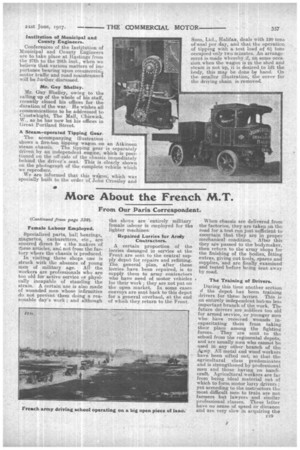More About the French M.T.
Page 13

Page 14

If you've noticed an error in this article please click here to report it so we can fix it.
From Our Paris Correspondent.
(Continued from page 338). Female Labour Employed.
Specialized parts ball bearings, Magnetos, carburetters, etc., are secured direct fr• e the makers of aese articles, and not from the factory where the chassis is produced.
In visiting these shops one is struck with the absence of young men of military age. All the workers are professionals who are too old for active service or physically incapable of standing the strain. A certain use is also made of wounded men whose infirmities do not prevent them doing a reasonable day's work ; and although the shoos are entirely military female tabour is employed for the lighter machines.
Repaired Lorries for Andy Contractors.
A certain proportion of the lorries danjaged in service at the Front are sent to the central supply depot for repairs and refitting. The general plan, after these lorries have been repaired, is to supply them to army contractors who have need of motor vehicles for their work ; they are not put on the open market. In some cases convoys are sent back to. this depot for a general overhaul, at the end of which they return to the Front. When chassis are delivered from the factories, they are taken on the road for a test run just sufficient to ascertain that they are in proper mechanical condition. After this they are passed to the body-maker, then return to the army shops for the finishing of the bodies, fitting extras, giving out tools, spares and• supplies, and are finally examined• and tested before being sent away by road.
• The Training of Drivers.
During this time another section if the depot has been training drivers for these lerries. This is an entirely independent but-no less important branch of the work. The future drivers are soldiers too old. for armed service, or younger men who have received wounds incapacitating them from taking their place among the fighting forces. They are sent to the school from the regimental depots, and are usually men who cannot be used in any other branch of the Aptly. All metal and wood workers have been sifted out, so that the agricultural class predominates and is strengthened by professional men and those having no handicraft. Agricultural workers are far from being ideal material out of which to form motor lorry drivers ; yet according to the instructors the most diffizult men to train are not farmers but lawyers and similar professional classes. These latter have no sense of speed or distance and are very slow in acquiring the c49
reflex movements which are the basis of good driving. The younger men—men under 30—make very apt .pupils, no matter from what class they are drawn.
The Instruction Ground.
This school has secured as its instruction ground a huge open space over which 50 or 60 cars can operate together without being a hindrance to one another. This is found much more advantageous than the open road, for accidents are reduced to a minimum, and drivers acquire confidence gradually. In order to teach the men to steer correctly and judge distance, lanes are formed by blocks or wood, placed at intervals on the ground,, and pupils are asked to form 0,11 kinds of figures between these obstacles. One end of the ground being hilly, an opportunity is provided for gearchanging and turning on gradients. A Fifteen Days Programme.
The French programme calls for drivers being produced at the end of 10 days instruction. Monitors admit that the task is a difficult one and would be impossible Ni5ede not for the high spirit which animates the pupils and the determination of all to Master the secrets of driving. It has to be admitted, too, that in order to adhere to such a programme pupils and the teaching staff have to work hard. From the morning of the first day when, they enter the school, to the end of the fifteenth when they 'leave it to go to the Front. with a convoy, the pupils are never away from cars or lorries, except for meals or sleep. Preliminary instruction is given . on touring cars. After. two or three • days the pupil can correctly steer ahead and reverse and change gear S in a passable manner. Ile is
• then transferred to .a lorry and the
whole of his instruction from that time is given on a lorry. After five days on the open ground he is fit to go on the road with 1i, lorry and operate with other vehicles.. During the .prelinainary itraining it has been impossible for him to cause an accident, for there have been no obstacles to hit ; when be goes on the road he is a sufficiently good driver to be safe. The last four or five days of the apprenticeship are spent entirely on the make of lorry the pupil will have to drive when he leaves the school ; previous to this, instruction is given on various makes.. Theoretical instruction is meagre, being just sufficient to familiarize the pupils with the working of a motor vehicle. So keen are the men, however, that practically all of them possess copies of some 'motor manual and study it in the little spare time which they have. Their progress is considerably accelerated thereby.






















